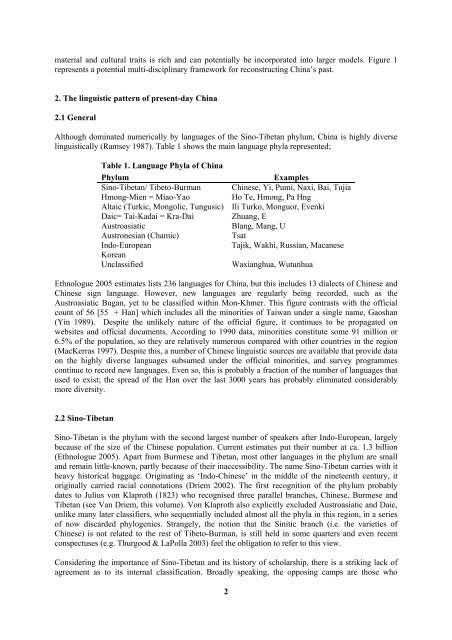Geneva paper 2004 submit.pdf - Roger Blench
Geneva paper 2004 submit.pdf - Roger Blench
Geneva paper 2004 submit.pdf - Roger Blench
Create successful ePaper yourself
Turn your PDF publications into a flip-book with our unique Google optimized e-Paper software.
material and cultural traits is rich and can potentially be incorporated into larger models. Figure 1<br />
represents a potential multi-disciplinary framework for reconstructing China’s past.<br />
2. The linguistic pattern of present-day China<br />
2.1 General<br />
Although dominated numerically by languages of the Sino-Tibetan phylum, China is highly diverse<br />
linguistically (Ramsey 1987). Table 1 shows the main language phyla represented;<br />
Table 1. Language Phyla of China<br />
Phylum<br />
Sino-Tibetan/ Tibeto-Burman<br />
Hmong-Mien = Miao-Yao<br />
Altaic (Turkic, Mongolic, Tungusic)<br />
Daic= Tai-Kadai = Kra-Dai<br />
Austroasiatic<br />
Austronesian (Chamic)<br />
Indo-European<br />
Korean<br />
Unclassified<br />
Examples<br />
Chinese, Yi, Pumi, Naxi, Bai, Tujia<br />
Ho Te, Hmong, Pa Hng<br />
Ili Turko, Monguor, Evenki<br />
Zhuang, E<br />
Blang, Mang, U<br />
Tsat<br />
Tajik, Wakhi, Russian, Macanese<br />
Waxianghua, Wutunhua<br />
Ethnologue 2005 estimates lists 236 languages for China, but this includes 13 dialects of Chinese and<br />
Chinese sign language. However, new languages are regularly being recorded, such as the<br />
Austroasiatic Bugan, yet to be classified within Mon-Khmer. This figure contrasts with the official<br />
count of 56 [55 + Han] which includes all the minorities of Taiwan under a single name, Gaoshan<br />
(Yin 1989). Despite the unlikely nature of the official figure, it continues to be propagated on<br />
websites and official documents. According to 1990 data, minorities constitute some 91 million or<br />
6.5% of the population, so they are relatively numerous compared with other countries in the region<br />
(MacKerras 1997). Despite this, a number of Chinese linguistic sources are available that provide data<br />
on the highly diverse languages subsumed under the official minorities, and survey programmes<br />
continue to record new languages. Even so, this is probably a fraction of the number of languages that<br />
used to exist; the spread of the Han over the last 3000 years has probably eliminated considerably<br />
more diversity.<br />
2.2 Sino-Tibetan<br />
Sino-Tibetan is the phylum with the second largest number of speakers after Indo-European, largely<br />
because of the size of the Chinese population. Current estimates put their number at ca. 1.3 billion<br />
(Ethnologue 2005). Apart from Burmese and Tibetan, most other languages in the phylum are small<br />
and remain little-known, partly because of their inaccessibility. The name Sino-Tibetan carries with it<br />
heavy historical baggage. Originating as ‘Indo-Chinese’ in the middle of the nineteenth century, it<br />
originally carried racial connotations (Driem 2002). The first recognition of the phylum probably<br />
dates to Julius von Klaproth (1823) who recognised three parallel branches, Chinese, Burmese and<br />
Tibetan (see Van Driem, this volume). Von Klaproth also explicitly excluded Austroasiatic and Daic,<br />
unlike many later classifiers, who sequentially included almost all the phyla in this region, in a series<br />
of now discarded phylogenies. Strangely, the notion that the Sinitic branch (i.e. the varieties of<br />
Chinese) is not related to the rest of Tibeto-Burman, is still held in some quarters and even recent<br />
conspectuses (e.g. Thurgood & LaPolla 2003) feel the obligation to refer to this view.<br />
Considering the importance of Sino-Tibetan and its history of scholarship, there is a striking lack of<br />
agreement as to its internal classification. Broadly speaking, the opposing camps are those who<br />
2
















